CFDC: A Spatiotemporal Change Detection Framework for Mapping Tree Planting Program Scenarios Using Landsat Time Series Images
Abstract
1. Introduction
- New afforestation: new forest establishment on previously non-forested lands.
- Densification: increasing tree density in sparsely wooded areas.
- Replacement afforestation: replacing existing forests with alternative species or management practices.
2. Study Area and Data
2.1. Study Area
2.2. Landsat Data and Preprocessing
2.3. Artificial Forest Mask Data
2.4. Sample Data
3. Methods
3.1. Spatial-Temporal Characteristics of TPPS
- New afforestation (Figure 3a) is identified by a rapid increase in Normalized Difference Vegetation Index (NDVI) values from near-zero levels, typically occurring within 1–3 years. This sharp change generates a clear breakpoint in the NDVI trajectory, indicating the initial establishment of artificial forests. Before this change, the surrounding pixels predominantly belong to non-forest classes (e.g., bare soil).
- Densification (Figure 3b) also shows a rapid NDVI increase and a detectable breakpoint, similar to new afforestation. However, its spatial context differs; the affected pixels are embedded within existing forest cover, reflecting increases in stand density or underplanting activities rather than expansion into previously non-forested areas.
- Replacement afforestation (Figure 3c) is characterized by a sharp decline in NDVI due to forest clearance or species replacement, followed by a gradual recovery with a distinct NDVI curve. In this case, both pre- and post-change neighborhoods consist of artificial forest, indicating forest management. Our definition of “decline followed by regrowth” is as follows:
- Initial Stable NDVI: The NDVI value of the forest remains a periodic stable fluctuation before the replacement event.
- Sharp Decline: The NDVI decreases significantly in the year of the replacement event.
- Regrowth and Stabilization: As new trees establish, the NDVI begins to rise, ultimately reaching new long-term stable cyclical fluctuation.
3.2. Construction of Spatiotemporal Coupling Module
3.2.1. Temporal Detection Module: Continuous Change Detection (CCD)
- It extracts the breakpoint timing, capturing the moment when a significant vegetation change occurs.
- It determines the direction and magnitude of NDVI change, which helps infer the nature of the TPPS.
3.2.2. Spatial Refinement Module: Focal Context (FC)-Based Neighborhood Context
- Edge (new afforestation candidate): e.g., AFP < 0.4
- Interior (densification candidate): e.g., AFP ≥ 0.7
- Uncertain or mixed type zone: e.g., 0.4 ≤ AFP < 0.7
3.2.3. Spatiotemporal Coupling Module
3.2.4. Rule-Based Discriminative Module Construction
3.3. Accuracy Evaluation Method
4. Results
4.1. TPPS Spatial Distribution
4.2. Spatiotemporal Changes of TPPS
4.3. Accuracy Evaluation
5. Discussion
5.1. Advantages and Disadvantages of CFDC
5.2. Future Application Prospects of CFDC
6. Conclusions
Author Contributions
Funding
Data Availability Statement
Conflicts of Interest
References
- Yao, L.; Liu, T.; Qin, J.; Jiang, H.; Yang, L.; Smith, P.; Chen, X.; Zhou, C.; Piao, S. Carbon sequestration potential of tree planting in China. Nat. Commun. 2024, 15, 8398. [Google Scholar] [CrossRef]
- Kim, J.; Lim, C.-H.; Jo, H.-W.; Lee, W.-K. Phenological classification using deep learning and the sentinel-2 satellite to identify priority afforestation sites in North Korea. Remote Sens. 2021, 13, 2946. [Google Scholar] [CrossRef]
- Cheng, K.; Su, Y.; Guan, H.; Tao, S.; Ren, Y.; Hu, T.; Ma, K.; Tang, Y.; Guo, Q. Mapping China’s planted forests using high resolution imagery and massive amounts of crowdsourced samples. ISPRS J. Photogramm. Remote Sens. 2023, 196, 356–371. [Google Scholar] [CrossRef]
- Ding, Z.; Zheng, H.; Liu, Y.; Zeng, S.; Yu, P.; Shi, W.; Tang, X. Spatiotemporal patterns of ecosystem restoration activities and their effects on changes in terrestrial gross primary production in Southwest China. Remote Sens. 2021, 13, 1209. [Google Scholar] [CrossRef]
- Zhen, J.; Mao, D.; Shen, Z.; Zhao, D.; Xu, Y.; Wang, J.; Jia, M.; Wang, Z.; Ren, C. Performance of xgboost ensemble learning algorithm for mangrove species classification with multisource spaceborne remote sensing data. J. Remote Sens. 2024, 4, 0146. Available online: https://spj.science.org/doi/10.34133/remotesensing.0146 (accessed on 23 June 2025). [CrossRef]
- Wang, M.; Zheng, Y.; Huang, C.; Meng, R.; Pang, Y.; Jia, W.; Zhou, J.; Huang, Z.; Fang, L.; Zhao, F. Assessing Landsat-8 and Sentinel-2 spectral-temporal features for mapping tree species of northern plantation forests in Heilongjiang Province, China. For. Ecosyst. 2022, 9, 100032. [Google Scholar] [CrossRef]
- Yang, Y.; Meng, Z.; Zu, J.; Cai, W.; Wang, J.; Su, H.; Yang, J. Fine-scale mangrove species classification based on uav multispectral and hyperspectral remote sensing using machine learning. Remote Sens. 2024, 16, 3093. [Google Scholar] [CrossRef]
- Xiao, Y.; Wang, Q.; Zhang, H.K. Global Natural and Planted Forests Mapping at Fine Spatial Resolution of 30 m. J. Remote Sens. 2024, 4, 0204. Available online: https://spj.science.org/doi/10.34133/remotesensing.0204 (accessed on 23 June 2025). [CrossRef]
- Huang, Z.; Zhong, L.; Zhao, F.; Wu, J.; Tang, H.; Lv, Z.; Xu, B.; Zhou, L.; Sun, R.; Meng, R. A spectral-temporal constrained deep learning method for tree species mapping of plantation forests using time series Sentinel-2 imagery. ISPRS J. Photogramm. Remote Sens. 2023, 204, 397–420. [Google Scholar] [CrossRef]
- Liang, X.; Chen, J.; Gong, W.; Puttonen, E.; Wang, Y. Influence of data and methods on high-resolution imagery-based tree species recognition considering phenology: The case of temperate forests. Remote Sens. Environ. 2025, 323, 114654. [Google Scholar] [CrossRef]
- Onishi, M.; Ise, T. Explainable identification and mapping of trees using UAV RGB image and deep learning. Sci. Rep. 2021, 11, 903. [Google Scholar] [CrossRef]
- Korznikov, K.A.; Kislov, D.E.; Altman, J.; Doležal, J.; Vozmishcheva, A.S.; Krestov, P.V. Using U-Net-like deep convolutional neural networks for precise tree recognition in very high resolution RGB (red, green, blue) satellite images. Forests 2021, 12, 66. [Google Scholar] [CrossRef]
- Fu, M.; Lu, C.; Mao, Y.; Zhang, X.; Wu, Y.; Luo, H.; Liu, Z.; Li, W.; Ou, G. An efficient and accurate deep learning method for tree species classification that integrates depthwise separable convolution and dilated convolution using hyperspectral data. Int. J. Digital Earth 2024, 17, 2307999. [Google Scholar] [CrossRef]
- Wu, J.; Chen, L.; Wang, J.; Li, Y.; Chen, E.; Zhang, X. A novel framework combining band selection algorithm and improved 3D prototypical network for tree species classification using airborne hyperspectral images. Comput. Electron. Agric. 2024, 219, 108813. [Google Scholar] [CrossRef]
- Luo, M.; Tian, Y.; Zhang, S.; Huang, L.; Wang, H.; Liu, Z.; Yang, L. Individual tree detection in coal mine afforestation area based on improved Faster RCNN in UAV RGB images. Remote Sens. 2022, 14, 5545. [Google Scholar] [CrossRef]
- Henrich, J.; van Delden, J.; Seidel, D.; Kneib, T.; Ecker, A.S. TreeLearn: A deep learning method for segmenting individual trees from ground-based LiDAR forest point clouds. Ecol. Inf. 2024, 84, 102888. [Google Scholar] [CrossRef]
- Shen, X.; Huang, Q.; Wang, X.; Li, J.; Xi, B. A deep learning-based method for extracting standing wood feature parameters from terrestrial laser scanning point clouds of artificially planted forest. Remote Sens. 2022, 14, 3842. [Google Scholar] [CrossRef]
- Kennedy, R.E.; Yang, Z.; Cohen, W.B.J.R.S.o.E. Detecting trends in forest disturbance and recovery using yearly Landsat time series: 1. LandTrendr—Temporal segmentation algorithms. Remote Sens. Environ. 2010, 114, 2897–2910. [Google Scholar] [CrossRef]
- Verbesselt, J.; Hyndman, R.; Newnham, G.; Culvenor, D. Detecting trend and seasonal changes in satellite image time series. Remote Sens. Environ. 2010, 114, 106–115. [Google Scholar] [CrossRef]
- Browning, D.M.; Maynard, J.J.; Karl, J.W.; Peters, D.C. Breaks in MODIS time series portend vegetation change: Verification using long-term data in an arid grassland ecosystem. Ecol. Appl. 2017, 27, 1677–1693. [Google Scholar] [CrossRef] [PubMed]
- Zhu, Z.; Woodcock, C.E.J.R.s.o.E. Continuous change detection and classification of land cover using all available Landsat data. Remote Sens. Environ. 2014, 144, 152–171. [Google Scholar] [CrossRef]
- Arévalo, P.; Bullock, E.L.; Woodcock, C.E.; Olofsson, P. A Suite of Tools for Continuous Land Change Monitoring in Google Earth Engine. Front. Clim. 2020, 2, 576740. [Google Scholar] [CrossRef]
- Moraes, D.; Barbosa, B.; Costa, H.; Moreira, F.D.; Benevides, P.; Caetano, M.; Campagnolo, M. Continuous forest loss monitoring in a dynamic landscape of Central Portugal with Sentinel-2 data. Int. J. Appl. Earth Obs. Geoinf. 2024, 130, 103913. [Google Scholar] [CrossRef]
- Miguel, S.; Ruiz-Benito, P.; Rebollo, P.; Viana-Soto, A.; Mihai, M.C.; García-Martín, A.; Tanase, M. Forest disturbance regimes and trends in continental Spain (1985–2023) using dense landsat time series. Environ. Res. 2024, 262, 119802. [Google Scholar] [CrossRef]
- Chen, S.; Woodcock, C.E.; Bullock, E.L.; Arévalo, P.; Torchinava, P.; Peng, S.; Olofsson, P. Monitoring temperate forest degradation on Google Earth Engine using Landsat time series analysis. Remote Sens. Environ. 2021, 265, 112648. [Google Scholar] [CrossRef]
- Wu, Q.; Liu, K.; Song, C.; Wang, J.; Ke, L.; Ma, R.; Zhang, W.; Pan, H.; Deng, X. Remote sensing detection of vegetation and landform damages by coal mining on the Tibetan Plateau. Sustainability 2018, 10, 3851. [Google Scholar] [CrossRef]
- Wang, Z.; Wei, C.; Liu, X.; Zhu, L.; Yang, Q.; Wang, Q.; Zhang, Q.; Meng, Y. Object-based change detection for vegetation disturbance and recovery using Landsat time series. GISci. Remote Sens. 2022, 59, 1706–1721. [Google Scholar] [CrossRef]
- Wang, H.; Xie, M.; Li, H.; Feng, Q.; Zhang, C.; Bai, Z. Monitoring ecosystem restoration of multiple surface coal mine sites in China via LANDSAT images using the Google Earth Engine. Land Degrad. Dev. 2021, 32, 2936–2950. [Google Scholar] [CrossRef]
- Xu, K.; Lin, W.; Zhang, N. Comparative analysis of forest disturbance detection in the key state-owned forest region of the Greater Khingan Range of China based on different algorithms. Geocarto Int. 2025, 40, 2489526. [Google Scholar] [CrossRef]
- Liu, Y.; Xie, M.; Liu, J.; Wang, H.; Chen, B. Vegetation disturbance and recovery dynamics of different surface mining sites via the LandTrendr algorithm: Case study in Inner Mongolia, China. Land 2022, 11, 856. [Google Scholar] [CrossRef]
- Cohen, W.B.; Yang, Z.; Healey, S.P.; Kennedy, R.E.; Gorelick, N. A LandTrendr multispectral ensemble for forest disturbance detection. Remote Sens. Environ. 2018, 205, 131–140. [Google Scholar] [CrossRef]
- Zhu, Z. Change detection using landsat time series: A review of frequencies, preprocessing, algorithms, and applications. ISPRS J. Photogramm. Remote Sens. 2017, 130, 370–384. [Google Scholar] [CrossRef]
- Pasquarella, V.J.; Arévalo, P.; Bratley, K.H.; Bullock, E.L.; Gorelick, N.; Yang, Z.; Kennedy, R.E. Demystifying LandTrendr and CCDC temporal segmentation. Int. J. Appl. Earth Obs. Geoinf. 2022, 110, 102806. [Google Scholar] [CrossRef]
- Ye, S.; Rogan, J.; Zhu, Z.; Eastman, J.R. A near-real-time approach for monitoring forest disturbance using Landsat time series: Stochastic continuous change detection. Remote Sens. Environ. 2021, 252, 112167. [Google Scholar] [CrossRef]
- Liang, Y.; Shang, R.; Chen, J.M.; Lin, X.; Li, P.; Yang, Z.; Fan, L.; Xu, S.; Lin, Y.; Chen, Y. Comprehensive comparison and validation of forest disturbance monitoring algorithms based on Landsat time series in China. Remote Sens. 2025, 17, 680. [Google Scholar] [CrossRef]
- Yang, J.; Huang, X. 30 m Annual Land Cover and Its Dynamics in China from 1990 to 2019 (1.0.0) [Data Set]. Zenodo. 2021. Available online: https://zenodo.org/records/4417810 (accessed on 12 August 2025).
- Xiao, Y. Global Natural and Planted Forests Mapping at Fine Spatial Resolution of 30 m [Data Set]. Zenodo. 2024. Available online: https://zenodo.org/records/10701417 (accessed on 12 August 2025).
- Qian, S.; Xue, Z.; Jia, M.; Chen, Y.; Su, H. Temporal-spectral-semantic-aware convolutional transformer network for multi-class tidal wetland change detection in Greater Bay Area. ISPRS J. Photogramm. Remote Sens. 2024, 216, 126–141. [Google Scholar] [CrossRef]
- Chen, S.; Olofsson, P.; Saphangthong, T.; Woodcock, C.E. Monitoring shifting cultivation in Laos with Landsat time series. Remote Sens. Environ. 2023, 288, 113507. [Google Scholar] [CrossRef]
- Yang, S.; Mountrakis, G. Forest dynamics in the US indicate disproportionate attrition in western forests, rural areas and public lands. PLoS ONE 2017, 12, e0171383. [Google Scholar] [CrossRef]
- Riitters, K.H.; Wickham, J.D. Decline of forest interior conditions in the conterminous United States. Sci. Rep. 2012, 2, 653. [Google Scholar] [CrossRef] [PubMed]
- Shen, W.; Mao, X.; He, J.; Dong, J.; Huang, C.; Li, M. Understanding current and future fragmentation dynamics of urban forest cover in the Nanjing Laoshan Region of Jiangsu, China. Remote Sens. 2020, 12, 155. [Google Scholar] [CrossRef]
- Zhang, M.; Liu, P.; Liu, K.; Zhao, Z. Multiscale Sensitivity Analysis of Landscape Fragmentation in Plantation Forests on the Loess Plateau. Land Degrad. Dev. 2025, 36, 1885–1899. [Google Scholar] [CrossRef]
- Fu, H.; Zhao, W.; Zhan, Q.; Yang, M.; Xiong, D.; Yu, D. Temporal Information Extraction for Afforestation in the Middle Section of the Yarlung Zangbo River Using Time-Series Landsat Images Based on Google Earth Engine. Remote Sens. 2021, 13, 4785. [Google Scholar] [CrossRef]
- Yang, Q.; Zhang, H.; Peng, W.; Lan, Y.; Luo, S.; Shao, J.; Chen, D.; Wang, G. Assessing climate impact on forest cover in areas undergoing substantial land cover change using Landsat imagery. Sci. Total Environ. 2019, 659, 732–745. [Google Scholar] [CrossRef]
- Corenblit, D.; Piégay, H.; Arrignon, F.; González-Sargas, E.; Bonis, A.; Ebengo, D.M.; Garófano-Gómez, V.; Gurnell, A.M.; Henry, A.L.; Hortobágyi, B. Interactions between vegetation and river morphodynamics. Part II: Why is a functional trait framework important? Earth Sci. Rev. 2024, 253, 104709. [Google Scholar] [CrossRef]
- Pearse, G.D.; Tan, A.Y.; Watt, M.S.; Franz, M.O.; Dash, J.P. Detecting and mapping tree seedlings in UAV imagery using convolutional neural networks and field-verified data. ISPRS J. Photogramm. Remote Sens. 2020, 168, 156–169. [Google Scholar] [CrossRef]
- de Paula Pires, R.; Axelsson, C.; Lindberg, E.; Persson, H.J.; Olofsson, K.; Holmgren, J. Boreal tree species classification using airborne laser scanning data annotated with harvester production reports, and convolutional neural networks. Int. J. Appl. Earth Obs. Geoinf. 2025, 140, 104607. [Google Scholar] [CrossRef]

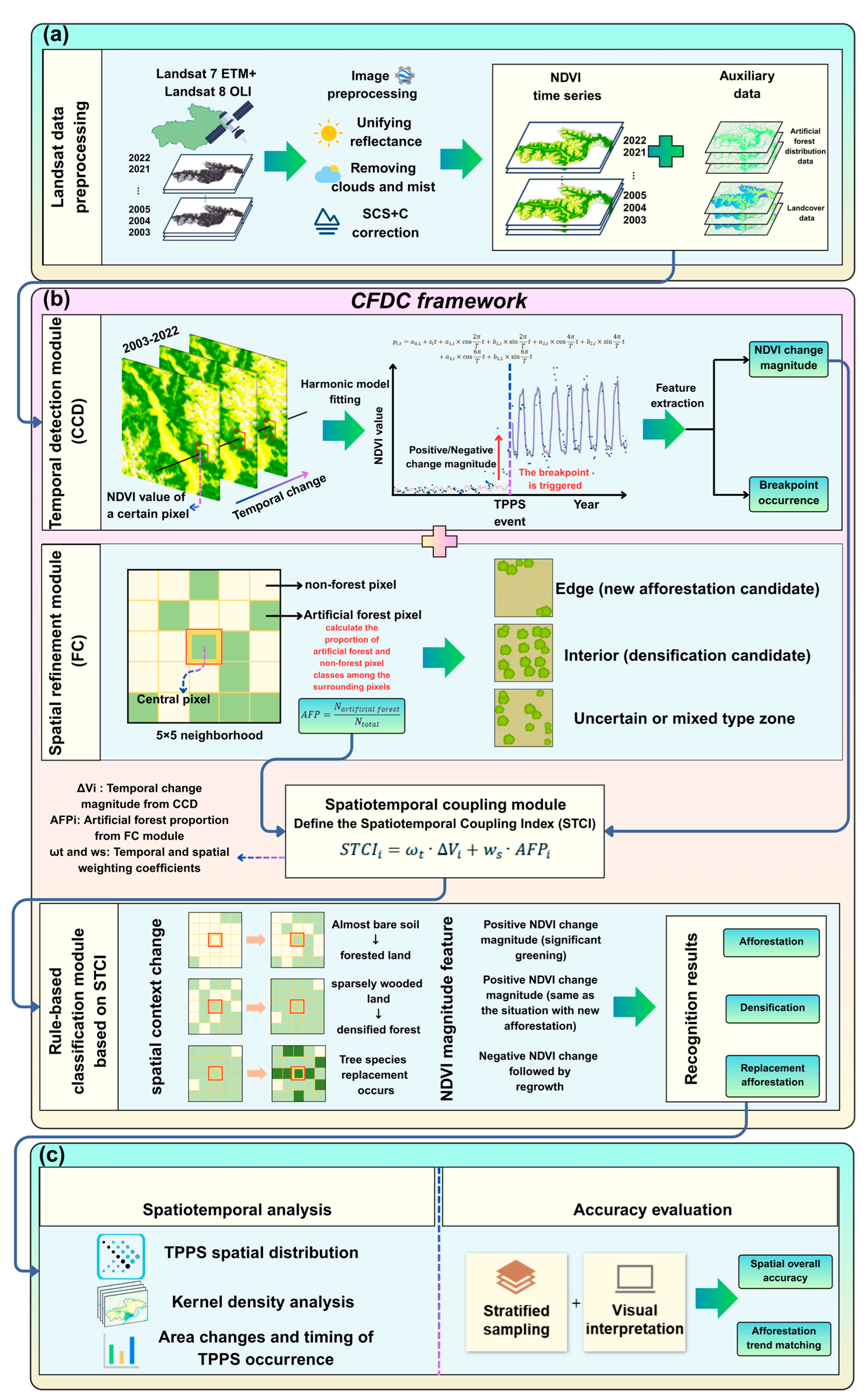

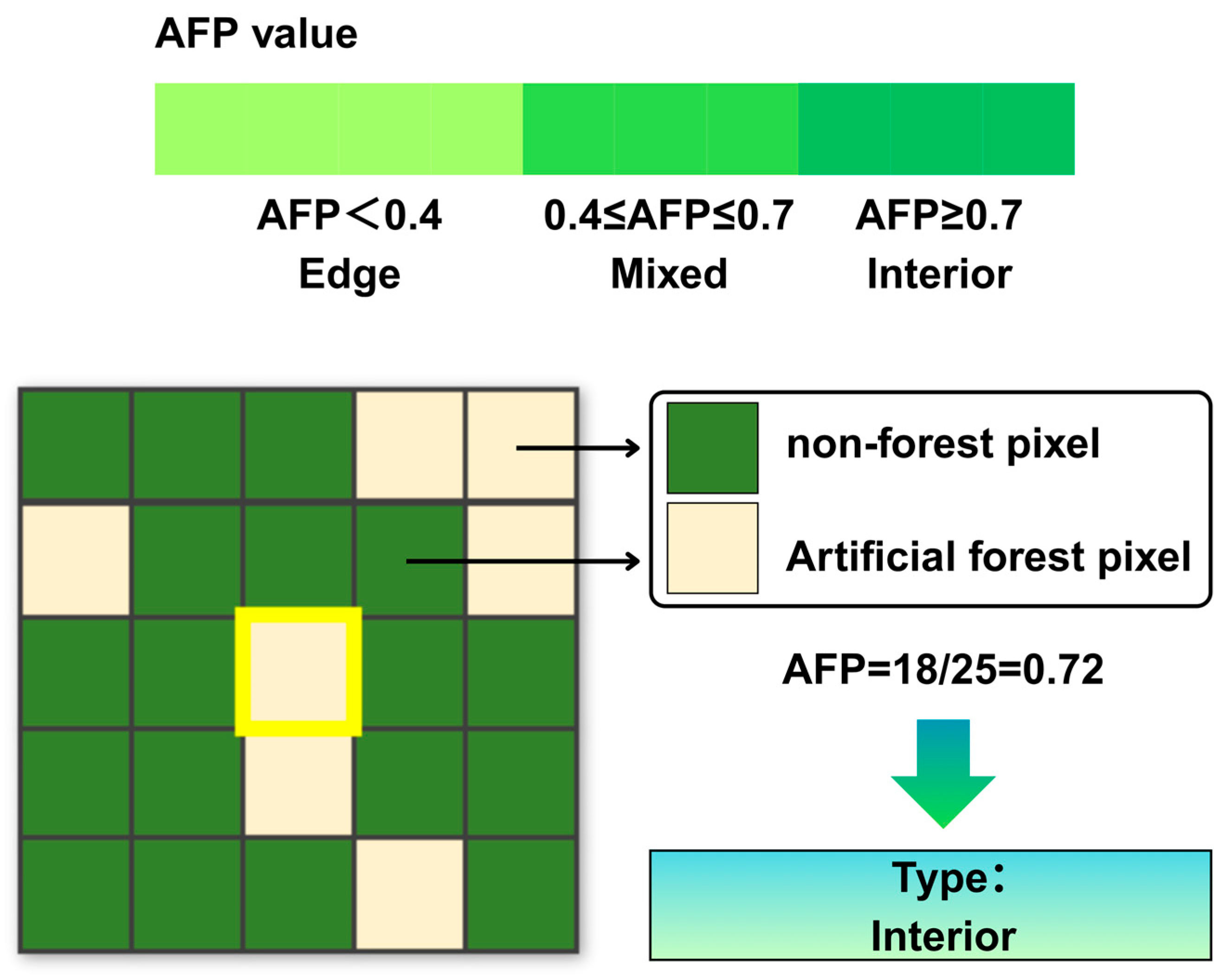
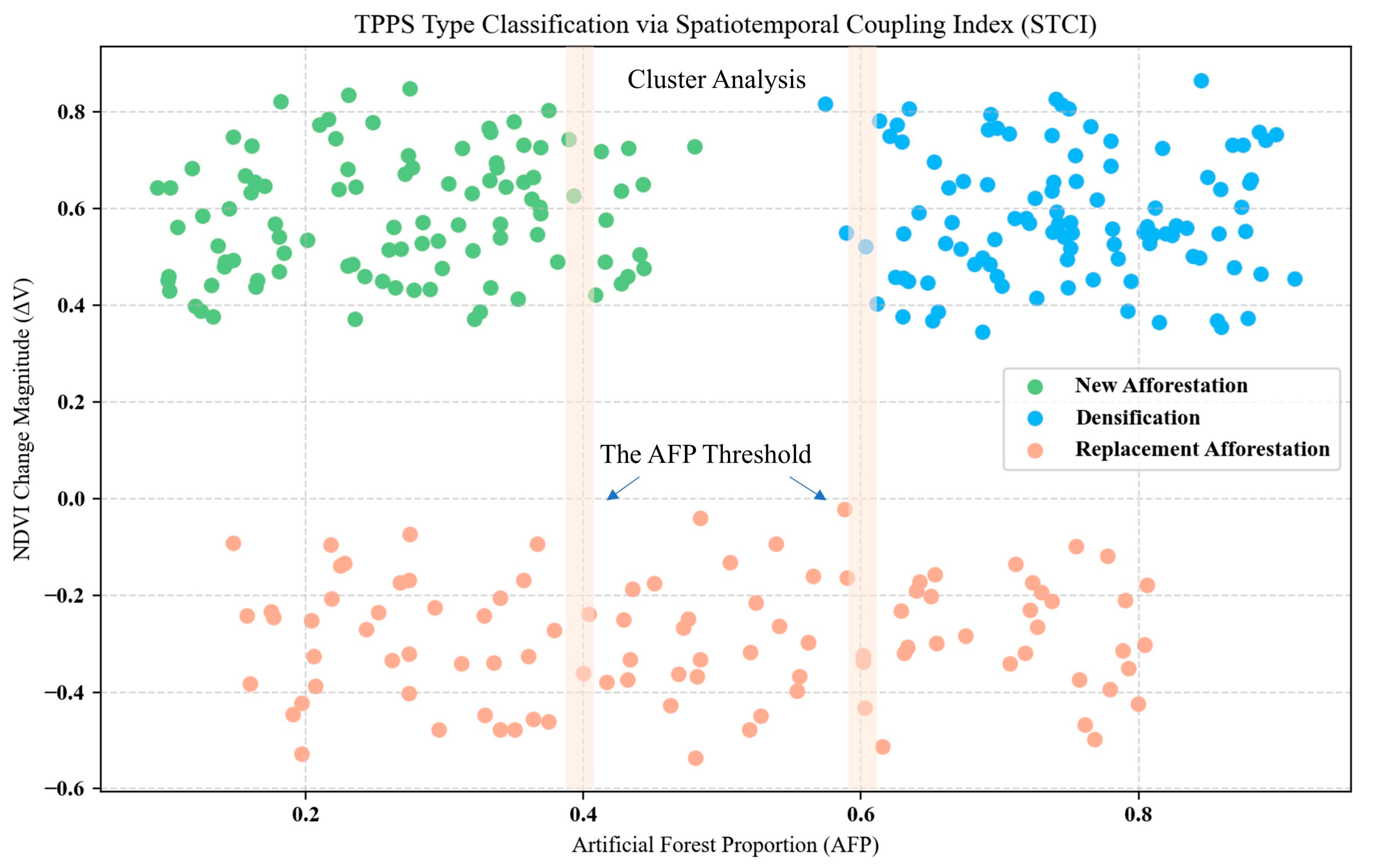
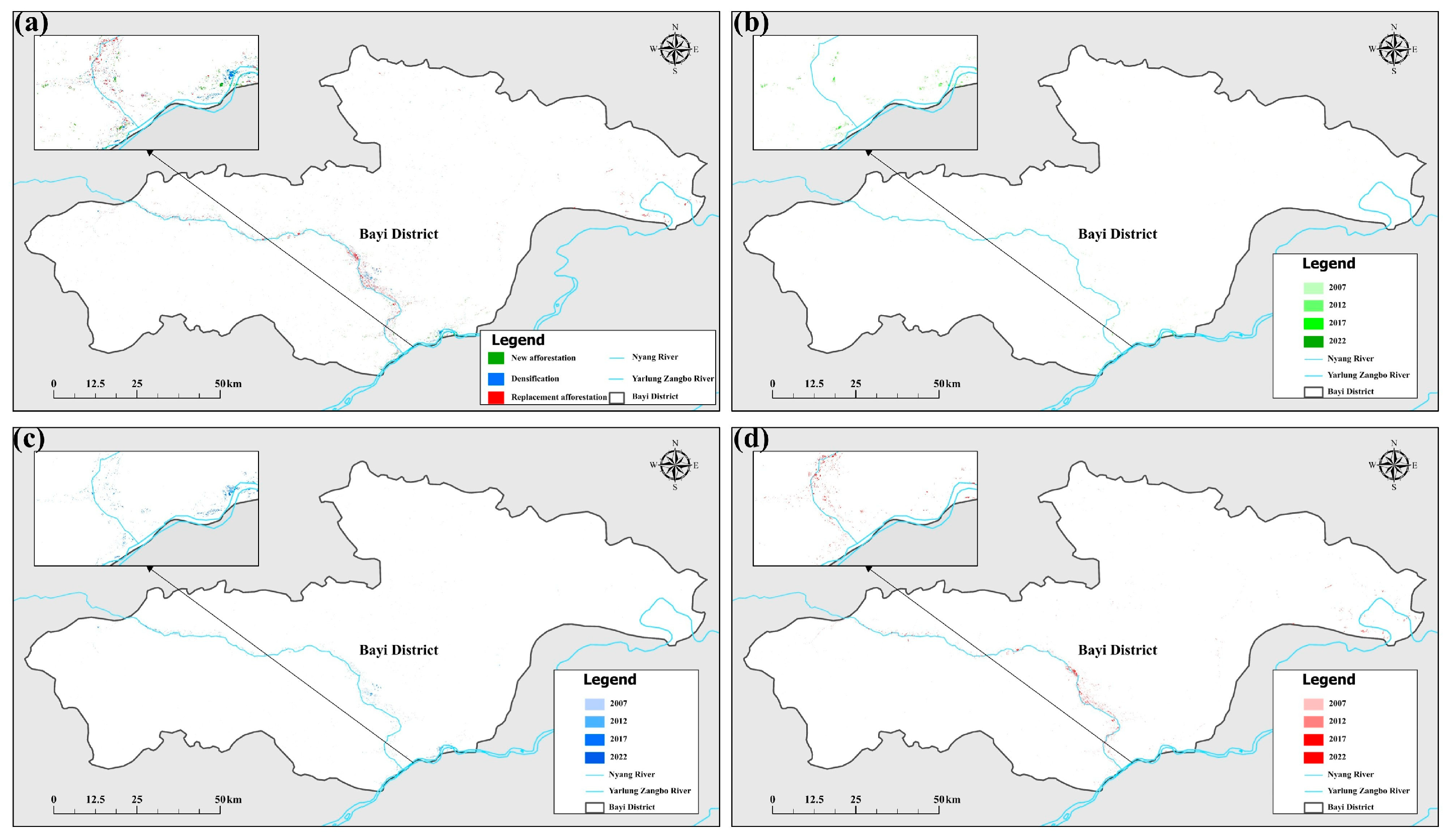

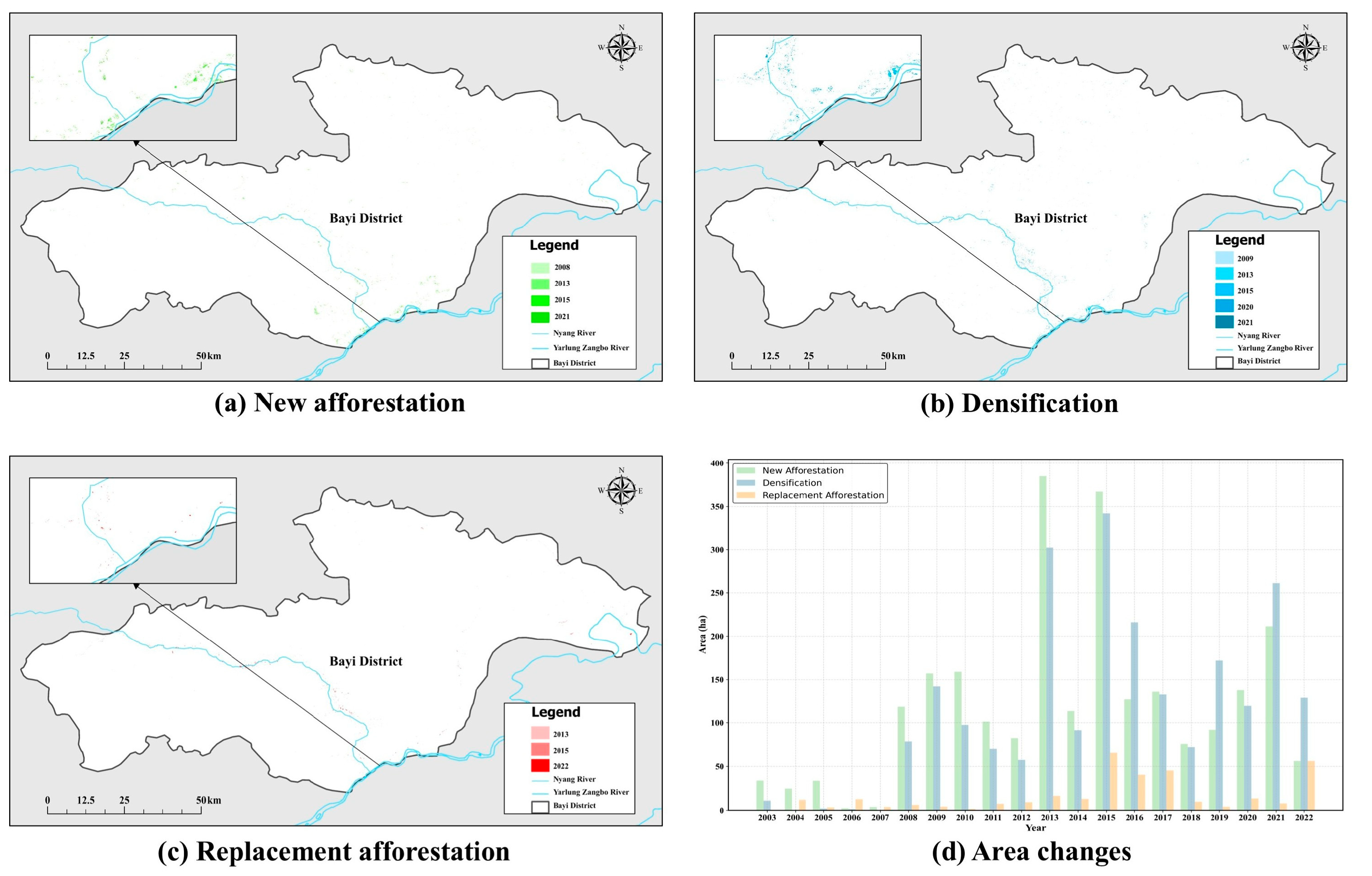
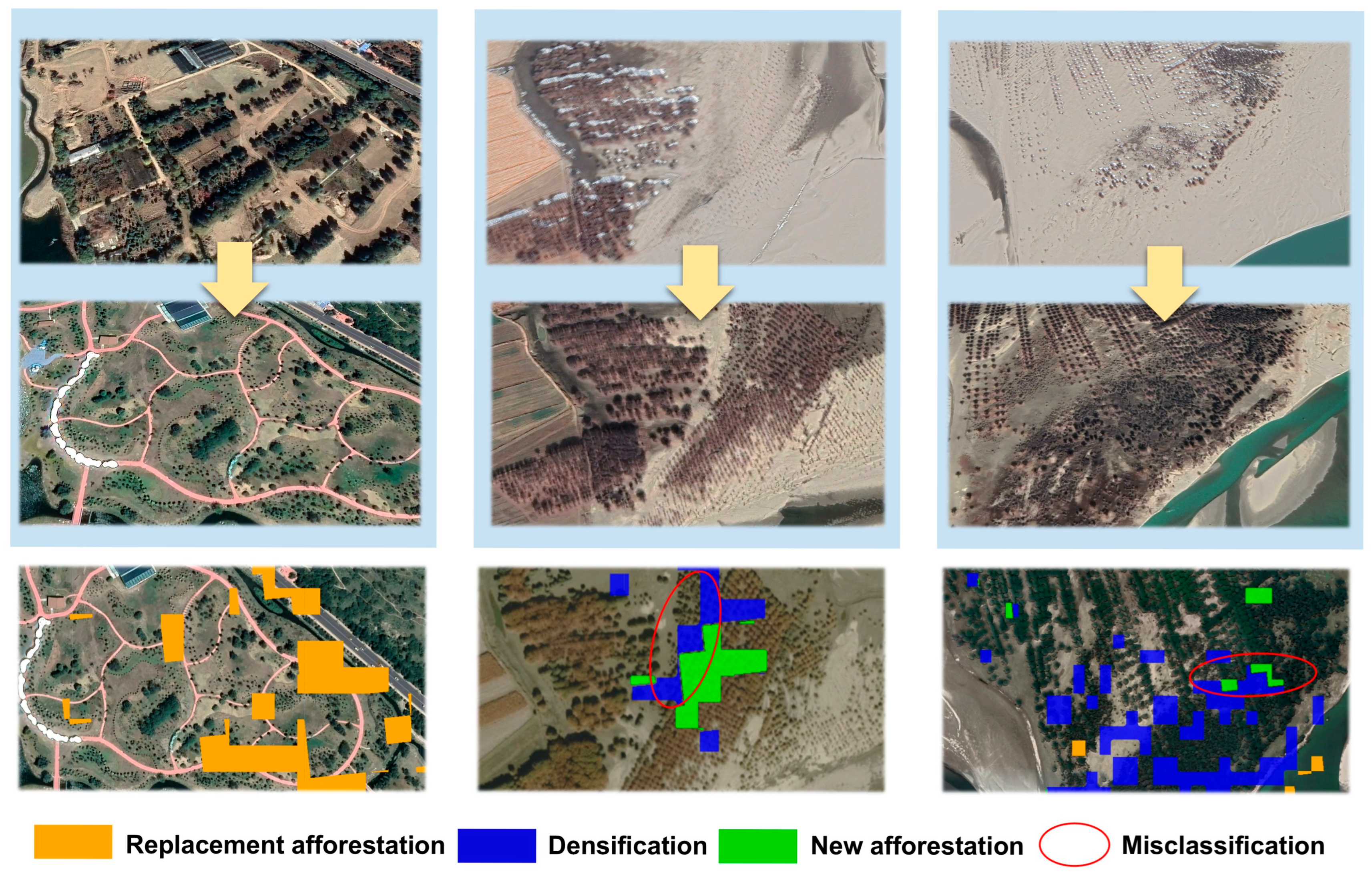
| Data Type | Period | Spatial Resolution | Data Source |
|---|---|---|---|
| China 30 m Annual Land Cover Data | 1990–2022 | 30 m | [36] |
| Global 30 m Forest Distribution Data | 1985–2021 | 30 m | [37] |
| TPPS Type | Temporal Feature (CCD) | Spatial Feature (FC) | STCI Pattern Expression |
|---|---|---|---|
| New Afforestation | Positive NDVI change magnitude (significant greening) | Adjacent to non-forest areas, primarily at edges | Strong temporal change + edge spatial context |
| Densification | Positive NDVI change magnitude (same as the situation with new afforestation) | Completely surrounded by existing forest | Strong temporal change + internal spatial context |
| Replacement | Negative change followed by regrowth | Minimal spatial shift | Strong temporal fluctuation + stable spatial context |
| Validated Year | Overall Accuracy (OA) | User’s Accuracy (UA) | ||
|---|---|---|---|---|
| New Afforestation | Densification | Replacement Afforestation | ||
| 2007 | 81.5% | 81.1% | 80.0% | 81.8% |
| 2012 | 81.0% | 78.6% | 83.3% | 81.1% |
| 2017 | 76.0% | 66.7% | 68.2% | 80.0% |
| 2022 | 82.5% | 76.7% | 82.2% | 85.0% |
| Average | 80.25% | 75.78% | 78.43% | 81.98% |
Disclaimer/Publisher’s Note: The statements, opinions and data contained in all publications are solely those of the individual author(s) and contributor(s) and not of MDPI and/or the editor(s). MDPI and/or the editor(s) disclaim responsibility for any injury to people or property resulting from any ideas, methods, instructions or products referred to in the content. |
© 2025 by the authors. Licensee MDPI, Basel, Switzerland. This article is an open access article distributed under the terms and conditions of the Creative Commons Attribution (CC BY) license (https://creativecommons.org/licenses/by/4.0/).
Share and Cite
Yu, K.; Tian, L.; Sun, Z.; Huang, X. CFDC: A Spatiotemporal Change Detection Framework for Mapping Tree Planting Program Scenarios Using Landsat Time Series Images. Remote Sens. 2025, 17, 2864. https://doi.org/10.3390/rs17162864
Yu K, Tian L, Sun Z, Huang X. CFDC: A Spatiotemporal Change Detection Framework for Mapping Tree Planting Program Scenarios Using Landsat Time Series Images. Remote Sensing. 2025; 17(16):2864. https://doi.org/10.3390/rs17162864
Chicago/Turabian StyleYu, Kuai, Lingwen Tian, Zhangli Sun, and Xiaojuan Huang. 2025. "CFDC: A Spatiotemporal Change Detection Framework for Mapping Tree Planting Program Scenarios Using Landsat Time Series Images" Remote Sensing 17, no. 16: 2864. https://doi.org/10.3390/rs17162864
APA StyleYu, K., Tian, L., Sun, Z., & Huang, X. (2025). CFDC: A Spatiotemporal Change Detection Framework for Mapping Tree Planting Program Scenarios Using Landsat Time Series Images. Remote Sensing, 17(16), 2864. https://doi.org/10.3390/rs17162864





